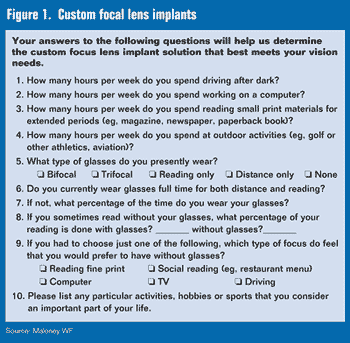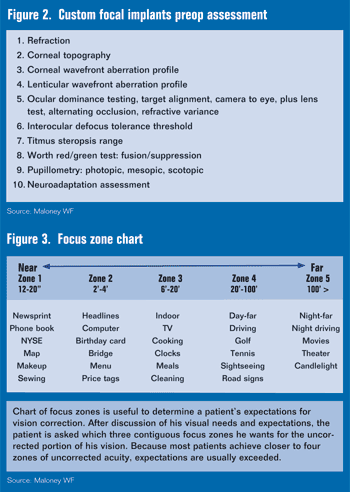Night driving vision: A major challenge in presbyopia correction
Patients who expect to do more than occasional driving after dark must know that the distance compromises may be a significant challenge.
Click Here to Manage Email Alerts
![Lens-Based Refractive Surgery [logo]](/~/media/images/shared-images/lens-based_275_82_19931.gif)
The treatment of presbyopia can be satisfying for both patient and surgeon. Successful restoration of reading vision can have such a profound impact that the typical candidate is willing to accept the distance vision compromises inherent in all current lens implant corrections of presbyopia.
We have seen that the specific compromises vary with each lens implant approach. The most successful presbyopia treatments use the best approach for each candidate according to his individual presbyopia profile.
One of the most important elements of this profile is the candidate’s night driving requirements. Depending on the specific reading vision they seek at the other end of the focus spectrum (Figure 3), patients who expect to do more than occasional driving after dark must know that the distance compromises may be a significant challenge. They must understand and anticipate this challenge if they are to ultimately see their surgery as a success.
Night driving vision compromise
Decreased scotopic visual acuity is almost universal and not limited to patients who have undergone presbyopia correction. An enlarged scotopic pupil induces an increase in a range of lower- and higher-order aberrations, in particular spherical aberration, even in the normal eye. These dark-induced aberrations are greater in the typical conventional pseudophakic eye.
|
|
Edge glare and other pseudophakic dysphotopsias that go undetected during the day can be significantly increased in scotopic conditions. Even slight posterior capsular changes or minor lens decentration can become problematic while driving at night. We know this from our cataract patients. In short, uncorrected night driving vision is usually compromised with any distance-focused IOL, even before we attempt to address reading focus.
When we add presbyopia to the corrective equation, the distance visual acuity is going to be compromised even further because all presbyopia correction requires some degree of myopic defocus.
The zonal myopic defocus utilized in both the Array (Advanced Medical Optics) and ReSTOR (Alcon) multifocal implants must be added to the list of distance vision compromises. So, too, must the myopic defocus that is employed in conjunction with pseudoaccommodation in the conventional IOL approach we have discussed previously.
Importantly, all evidence to date indicates that the Crystalens accommodating IOL (eyeonics), regardless of what its mechanism of action may be, cannot deliver true zone 1 reading acuity without the additional accommodative effect of at least 1 D of myopic defocus in one eye. It has become clear to me that currently myopic defocus is an essential tool employed in all presbyopia corrections.

Dealing with defocus
New presbyopic IOL technology points to a day when the IOL itself will be capable of providing the entire range of accommodative effect needed to restore full reading focus. Until that day comes, we are working in the realm of presbyopia treatments, not a cure. And until that day comes, those of us treating presbyopia are going to be dealing with myopic defocus. This important tool, however, is a two-edged sword — enhancing reading while compromising distance focus. Balancing these two opposing influences according to each patient’s needs and expectations is central to surgical success.
The art of “deal with defocus” has been the central theme of this column for several months. This is a subtle and nuanced art since it must take into account many variables of the patient’s visual status, lifestyle and surgical goals, and then match them with the lens implant approach most likely to deliver. That is why we have advocated an approach that centers on the question, “Which IOL is best for this patient?” rather than the more limited approach that relies on a single, favored IOL and then asks, “Which patients are candidates for this IOL?”
Today, as we consider the challenge of night driving in presbyopia correction, we elaborate more specifically on this question and ask, “How much myopic defocus can this patient’s adaptation mechanism tolerate (that is, suppress)? Is it enough to fully meet the stated reading goals while still providing the functional distance acuity sufficient for him to safely continue the night driving he expects to do?” To answer these critical questions, we return to key elements found in the patient’s presbyopia profile obtained from the preop questionnaire (Figure 1), testing results (Figure 2) and the focus zone chart (Figure 3).

Crucial questions
One of the most important entries in the preop questionnaire is the question that asks the candidate to state the number of hours spent driving at night per week. The response is often more important in determining the most effective presbyopia treatment than the patient’s specific reading goals.
Responses vary but tend to correlate with age. Elderly cataract patients (average age 76 years) who elect to have optional presbyopia correction at the time of their cataract surgery typically drive infrequently at night. Their response in our questionnaire is an average of 2.8 hours per week, and this is typically for very short distances in familiar surroundings.
Near-far trade-off
In general, this limited night driving allows a wider range of treatment options to enhance reading and other close focus activities, due primarily to the greater amount of myopic defocus that can be employed. In reference to the focus zone chart, candidates with this profile can do without zone 5 focus in favor of zones 1 and 2. For these patients, this near-far trade-off represents little or no practical distance compromise and results in a dramatic restoration of whatever range of reading vision they seek, even full zone 1.
As expected, younger candidates do more night driving. Those in their 60s (average 64 years) responded with an average of 7.4 hours of night driving per week, and those in their 50s (average 57 years) drive at night an average of 10.2 hours per week. These younger candidates are typically refractive lens exchange patients and present a significantly greater challenge, particularly when it comes to night driving.
Critical preop tests
These candidates need particular attention paid to select preop tests in order to assess what their night driving capability will be after presbyopia correction. Our goal is to determine the amount of myopic defocus each candidate is capable of accepting, particularly in scotopic conditions and whether or not this amount will be sufficient to meet their reading goals.
Pupilography
We measure the photopic, mesopic and scotopic pupil diameter in all candidates but scrutinize this data most carefully in those who state that they drive at night more than 3 hours per week. Inconveniently, these younger candidates with greater night driving needs generally have larger pupils, which can significantly exacerbate the effect of the myopic defocus employed to enhance their reading restoration.
Interocular defocus tolerance threshold
The details of this indispensable test were outlined in an earlier column. This test measures the amount of myopic defocus the candidate will likely tolerate. Myopic defocus is typically targeted for the nondominant eye. The interocular difference must be comfortably below the patient’s calculated blur tolerance threshold, which decreases during night driving and more so with larger pupils. Candidates with a low threshold are usually advised to expect to wear glasses while driving at night, particularly if their scotopic pupil diameter is greater than 4.8 mm.
Ocular dominance
Last month I detailed the five tests to determine ocular dominance that we employ in every presbyopia candidate: target alignment, camera to eye, plus lens test, alternating occlusion and refractive variance. It is primarily the strength of dominance that we are assessing with this battery of tests.
Strong dominance is equivalent to a strong blur suppression mechanism and a greater ability to accept myopic defocus in the nondominant eye even in scotopic conditions. Therefore, when we see brisk, unequivocal responses that consistently indicate the same dominant eye in all five tests, we know that the candidate has strong blur suppression and that we are more likely to be able to meet his night driving needs. A presbyopia candidate who demonstrates weak or crossed dominance, especially if the pupils are larger, is usually advised that night driving glasses will almost certainly be required, especially if he seeks full zone 1 reading.
Titmus stereopsis
We have come to appreciate the benefit of this test for presbyopia candidates, in particular in assessing their potential postop night driving capabilities. We have found an inverse correlation between the degree of stereopsis and the interocular defocus tolerance threshold.
Candidates with less than full stereopsis, the majority in the 60- to 80-year-old age group, consistently tolerate a higher degree of myopic defocus in all lighting conditions. A candidate who demonstrates full stereopsis will be less able to suppress the nondominant eye with myopic defocus. Here again, all else being equal, we usually tell these patients that they will likely need night driving glasses.
Liability issues
As we have seen, all pseudophakic patients likely have some degree of compromised vision for night driving. Those with uncorrected distance vision and those with uncorrected presbyopia correction have additional compromises with which to contend. We therefore include in the permanent medical record a signed statement by each patient declaring that they will only drive when they are certain that their vision is adequate to do so safely — even if they have passed their DMV vision test without correction.
The right questions
Presbyopia candidates who expect to do more than incidental night driving require careful, detailed preop assessment. Test results that determine their blur suppression capability must be considered with their individual reading vision goals so that we can answer the key question, “How much myopic defocus can this patient’s adaptation mechanism tolerate (that is, suppress)? Is it enough to fully meet their stated reading goals while still providing the distance vision they need to safely continue the night driving they expect to do?” Achieving just the right balance in this inevitable near-far trade-off is challenging but readily achievable with the necessary attention to the patient’s presbyopia profile. It is well worth the effort.
For Your Information:
- William F. Maloney, MD, is head of Eye Surgery Associates of Vista, Calif., and a well-known teacher of cataract and lens-based refractive surgery techniques. He can be reached at 2023 West Vista Way, Suite A, Vista, CA 92083 U.S.A.; +1-760-941-1400; fax: +1-760-941-9643; e-mail: maloneyeye@yahoo.com. In the interest of objectivity, Dr. Maloney has no financial interest in any ophthalmic product and has no financial relationship with any ophthalmic company.

![William F. Maloney, MD [photo]](/~/media/images/shared-images/maloney_70_90_19931.jpg)